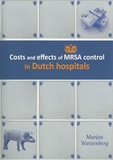Costs and effects of MRSA control in Dutch hospitals
Summary
In the Netherlands the prevalence of MRSA among S. aureus bloodstream isolates was as low as 0.7% in 2008. This low prevalence is maintained by a nationwide MRSA policy (also called search and destroy), that has been employed in Dutch hospitals since 1984. In the last years we have witnessed major changes in the Dutch MRSA epidemiology. Since 2003 a new MRSA strain (ST398), which originated from livestock, emerged in the Netherlands. Importantly, there is now a substantial number of MRSA carriers in the Netherlands with persistent (professional) exposure to ST398 MRSA in whom MRSA eradication will not be effective, due to repeated exposure. We performed a large Dutch multicenter study and calculated that the relative risk on transmission of MRSA ST398 in the hospital, as compared to healthcare associated (HA)-MRSA, was only 0.28. The calculated RA ratio between HA-MRSA and livestock associated MRSA was 5.9 (95% CI 2.2-23.8), suggesting livestock associated MRSA is almost six times less transmissible than HA-MRSA. Also, the MRSA prevalence among admitted patients suspected for MRSA carriage because of treatment in foreign hospitals appeared lower than previously reported: 1.6% and 1.9% in two Dutch multicenter trial we executed between 2005 and 2008. Besides changes in MRSA epidemiology, new rapid diagnostic tests (RDT) have become available that allow more rapid detection for MRSA carriage. The most important advantage of RDT is the reduction in unnecessary pre-emptive isolation days. RDT of MRSA reduced the number of pre-emptive isolation days with 48% and 60% when using chromogenic agar and MRSA PCR, respectively. Infection control policies to prevent S. aureus infections, both MSSA and MRSA, in the Netherlands are cost-saving, despite the costs to execute preventive control policies. Yet, cost-effectiveness of RDT for MRSA is unknown. In the Dutch multicenter trial the extra costs of screening and pre-emptive isolation of high risk patients were €95.77, €125.43 and €6.74 per isolation day avoided, using IDI PCR, GeneXpert PCR and chromogenic agar for MRSA screening, respectively. Since the additional costs of one extra isolation day on a regular ward in a non-outbreak situation were estimated to be €26.34, chromogenic screening, but not PCR-based screening, is a cost saving procedure. In conclusion, there is no need to pre-emptively isolate patients with a high risk for MRSA carriage on hospital admission. These patients can be screened using both RDT and conventional microbiological cultures. Closure of wards for new admissions is rarely necessary anymore when using PCR-based testing.
